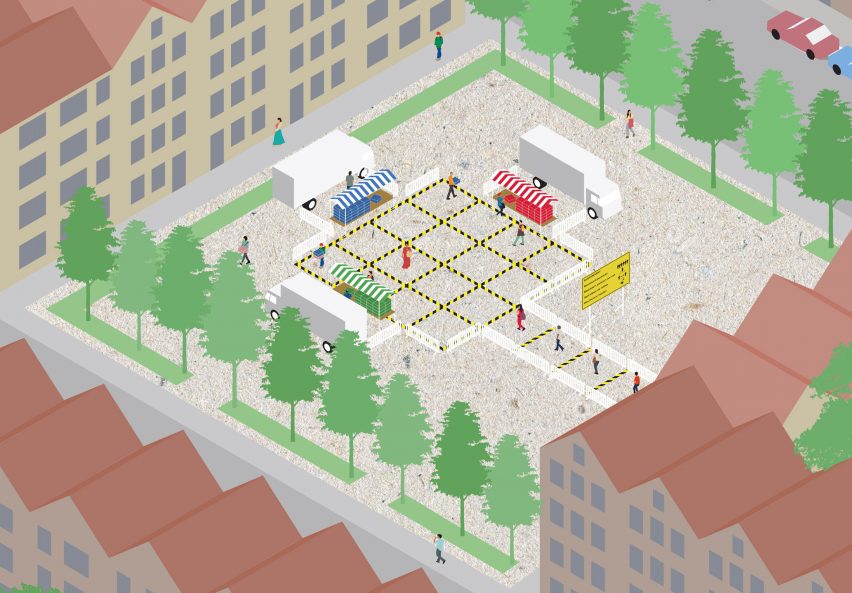Dutch studio Shift Architecture Urbanism has developed a model for a street food market where people can buy fresh produce without coming into contact with one another during the coronavirus pandemic.
Hyperlocal Micro Markets is a concept for a network of public markets, where customers can buy fruit and vegetables, dairy products, and meat and fish, without risking spread of coronavirus.
The design consists of 16-square grids that can be easily set up in the public squares of any town or city, allowing people to shop local while also following social distancing guidelines.
Shift Architecture Urbanism developed the proposal in response to the decision made by many cities around the world – including Rotterdam, where it is based – to close or restrict their public markets.
This is putting additional pressure on supermarkets, which can pose just as much of a contamination risk. Some people are having to wait in long queues to enter, only to find empty shelves when they eventually get in.
"Even with protective measures it seems very difficult if not impossible to rule out the risk of contamination in traditional fresh produce markets," said architects Thijs van Bijsterveldt, Oana Rades and Harm Timmermans.
"But this is also the case at the supermarkets that do stay open," they explained. "The social distancing rules are very hard to control and many people are touching the same products."
Another issue, according to the architects, is that not everyone can afford to buy all their groceries from the supermarket.
"Many households depend on the open-air market for their basic food needs," they said. "Closing the markets forces them to switch to the more expensive supermarkets, putting further financial pressure on these more vulnerable groups."
Shift's proposal is based around the idea that existing food markets could be split up and dispersed throughout local neighbourhoods. They call them "micro markets that operate on a hyper-local scale".
Each micro market consists of just three stalls, organised around the 16-square grid. There is one entrance but two exits, and each stall has two counters, one for order and one for collection.
Only six people are allowed into the space at one time, but they are able to move freely around. The only rule is that only one person may occupy a square on the grid at a time.
The stalls sell packages rather than individual products, in order to reduce the time each customer spends.
Setup and shutdown should be easy to manage too – markets traders are used to being flexible and mobile, setting up at different locations on different days.
"The former model of concentration has to be replaced by a model of dispersion, both in space and time," said the architects.
"This is done by breaking down the large markets into so-called micro markets that are spread over the city and opening them up for a longer time," they added. "Instead of you going to the market, the market is coming to your neighbourhood."
Shift is one of many architecture and design studios exploring strategies for dealing with coronavirus, but most so far have focused on healthcare. Carlo Ratti Associati and Jupe have both designed mobile hospital systems.
The architects believes the distribution of fresh food is a far easier problem to solve.
They hope their system can be put into practice. But they emphasise that, in order to work successfully, management of the markets needs to be overseen by the town or city council, to ensure that a variety of products are available every day.

